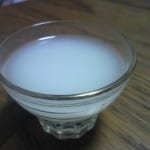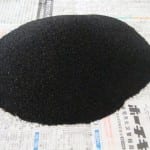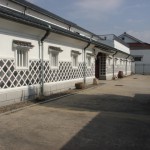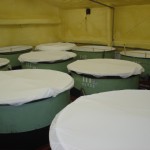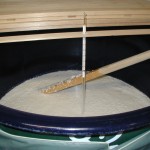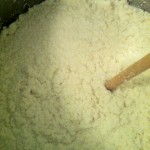There are many other types of sake that are less often seen than the main categories listed on the previous page. Some of these are industry marketing terms with little meaning or significance, others constitute vastly different types and styles of sake. Let us look at a few of them here below.
Nigori-zake
Nigori-zake (the s of sake becomes a z for the sake of pronounciation) is cloudy sake, sake that has not been pressed fully from the fermenting rice solids. Most people have seen it: the white, cloudy, usually opaque sake sometimes seen in shops and restaurants. That is nigori-zake, which simply means “cloudy sake.”The “clouds”are nothing more than unfermented rice solids deliberately left floating around inside.
There are several styles or forms that nigori-zake can take. Much nigori-zake is sweet and smooth and creamy in texture. Then there is the “o chunky you’l want to eat it with a fork”variety of nigori-zake.
Naturally, nigori-zake does not offer the subtlety and refinement of good premium sake. Although it can indeed be tasty and fun, the remaining lees and their flavor easily overpower any other fragrances or gentle nuances of flavor. Also, nigori-zake should always be served a bit chilled.
Yamahai-shikomi & Kimoto
Yamahai-shikomi and Kimoto sake are two variations on the brewing method in which the yeast starter is made in a special way that allows more funky yeast and bacteria to be pesent, often lending the sake a gamier, wilder flavor that can be fascinating.
That is the short answer. Here is the long answer.
From hundreds of years ago until the early 1900′s, it was thought that the rice and koji had to be mixed and crushed into a puree when creating the moto in order for them to work properly together and convert the starches to sugars. To achieve this, kurabito (brewery workers) would ram oar-like poles into the small vat for hours on end to make a smooth paste of the contents; exhausting work to say the least. This pole-ramming activity is known as yama-oroshi.
This yama-oroshi pole ramming is one of the most classic sake-brewing scenes around, and is commonly seen in paintings, and on old films at sake museums such as those at the larger breweries in Nada. It is during such activities that kurabito of old would sing traditional brewing songs, all but forgotten now, to keep them awake and active, and to help them count strokes.
Then, in 1909, Mr. Kinichiro Kagi at the National Institute for Brewing Studies discovered that all that hard work simply wasn’t necessary. If left alone, the enzymes in the koji would eventually dissolve all the rice in the developing moto anyway. No tiring pole-ramming was needed. The only catch was that you had to add a bit more water, and keep the temperature a bit warmer, a comparatively painless process. *Now you tell us!* rose the silent cry from countless exhausted brewery workers, past and present.
When it became known then that the rough part (yama-oroshi) could be ceased (hai-shi), yama-oroshi hai-shi, shortened to simply yamahai, was born.
But technology wasn’t finished poking fun at tradition. Ah, no, there was more mockery in store. In 1911 it was discovered that by adding a bit of lactic acid to the moto at the beginning, the whole thing could be accomplished in about half the time. Lactic acid is a product of the yeast life cycle, and when present in sufficient amounts, it prevents wild yeast and unwanted bacteria from proliferating and adversely affecting the flavor.
When the yamahai process is used, since the lactic acid comes into existence more slowly, a bit of funky bacteria and even wild yeast cells inevitably make it into the moto as it develops. This gives rise to gamier, more unabashed flavor profile in the end.
Yamahai moto takes about a month to develop, and can be nerve wracking as those stray bacteria and wild yeast cells can ruin a whole batch if they are not kept in check to some degree. Sanitation is paramount, and pains must be taken to keep the developing moto covered and protected.
Adding lactic acid at the beginning speeds the process up, allowing the moto to be ready for use in about two weeks. It also protects it from the start, putting everyone at ease.
This alter-ego of yamahai, in which a bit of lactic acid is added in the beginning, is known as sokujo moto, or *fast-developing* moto. Due to a characteristic resistance to new-fangled technology, it took about ten years for sokujo-moto to gain acceptance on an industry-wide basis. However, most sake today is created using sokujo moto method, as it is faster and easier and leads to a cleaner flavor. In a sense, yamahai is for those with more eclectic tastes.
Flavor-wise, what are the differences? Yamahai has a higher sweetness and acidity, with richer, deeper, significantly more pronounced flavors. A nice descriptive word for most yamahai is *gamy*. Sokujo-moto (i.e. most sake on the market) is comparatively milder and cleaner in flavor. However, there is oodles of overlap; yamahai sake can occasionally be clean and refined, and sokujo-moto sake can (once in a while) be wild and gamy. So in the end, extreme cases notwithstanding, it’s not a whole lot to get worked up about.
Many, many kura (breweries) make yamahai or kimoto sake, but not all. Some specialize in it even. Due to the strange yeastfellows involved, yamahai moto must be prepared in a separate room from the rest of the moto preparation.
The *Sake to Look For* section below lists several yamahai-shikomi sake to look for and taste. (The word shikomi here simply refers to creating a tank of sake.) Certainly a worthwhile experience.
So, what you need to take away from this newsletter, the one-liner executive summary so to speak, is this: for yamahai sake, the yeast starter was created in a slow and laborious way that allowed more wild yeasts and bacteria to become a part of the brew. This usually leads to a richer, tangier flavor. That should demystify things a bit. Anything else you need to know, your palate will tell you.
Kimoto
Beyond the standard method (sokujo moto) and the yamahai-shikomi method discussed above, there are a few other ways of creating this yeast starter.
One such method is known as kimoto. As mentioned above, until about 1920, all sake was made by mixing rice, koji, and water to a puree in order to help the yeast cells reproduce faster. This was the original method, and since originally this was the only method there was, there was no name to differentiate it from other methods. Later, they needed to give it a name, and this name was Kimoto.
Kimoto, then, is the original method. Indeed, even today, brewers creating sake made using a kimoto yeast starter will stand around a small tub and mix, mix, mix in a rhythmical, robotic action to mash up the rice, koji and yeast to a paste-like consistency. Monotonous and tiring work to be sure, but aren’t all traditional methods?
This activity, by the way, helps speed up the natural production of lactic acid in the moto. Lactic acid will then protect the developing moto from stray bacteria that would contribute to strange flavors or even spoil the sake.
A kimoto yeast starter takes a bit longer than yamahai to create, but ironically, the sake that results from these two methods is similar in flavor profile. Like sake brewed with yamahai moto, sake brewed with a kimoto moto has a higher sweetness and acidity, with richer, deeper, significantly more pronounced flavors. Bitterness in the recesses is not uncommon. As with all sake brewing methods, though, the moto used is only one factor. In fact, the intention and skill of the brewer will dictate more about the final product than how the yeast starter was created.
As kimoto can exhibit these rougher, more pronounced flavors, one does not usually see this type of brewing method used with very high grade sake. Kimoto (and yamahai as well) is more commonly seen in perhaps junmai-shu grade sake, and less so in ginjo or daiginjo sake, simply because of the usually delicate nature of ginjo and daiginjo sake. Such refined flavor profiles might be overpowered by the slightly harsher facets resulting from kimoto or yamahai.
But there are exceptions, and wonderful exceptions at that. Take Daishichi, from Fukushima, for example. Daishichi is a wonderful brewery that is not afraid to take technical risks. One of these risks was to be the first brewery to brew a ginjo-shu (and then a daiginjo-shu) from a kimoto yeast starter. Although now there are many other premium kimoto sake, it is far from being a common practice in ginjo-shu brewing.
Note, as alluded to above, that whether or not a sake is kimoto, yamahai, or sokujo moto is independent of its grade. There are kimoto and yamahai sake that are of all grades: futsuu-shu, junmai-shu, honjo-zo, and all forms of ginjo-shu (straight ginjo, junmai ginjo, straight daiginjo, and junmai daiginjo). They are but methods of creating the yeast starter.
Nama-zake and its variations
Although more easily found within Japan than without, nama-zake is one of the most easily enjoyable types of sake on the market.
In short, nama-zake is unpasteurized sake. Almost all sake (anything not labeled nama; probably 99% of all sake on the market) has been pasteurized twice; once just after brewing, and once again after a maturation period or before shipping. This is done by either running the sake through a pipe submerged in hot water (about 65C is the norm), or submerging already bottled sake in same.
Pasteurization is done to deactivate heat-sensitive enzymes and microorganisms left over from the koji and yeast cells, thus ensuring they will not kick in at higher temperatures (room temperature is enough to activate some of these) and send the sake flavors out of kilter.
On the other hand, sake that is not pasteurized – namazake – has a much fresher, livelier and zingier touch to the flavor, with usually a much more active aromatic aspect. Although care and refrigeration are needed to keep it fresh, and although the sake overall is much less stable, it often can be worth the hassle and effort.
Note, however, that there are several variations on leaving sake unpasteurized, and the handful of terms used to refer to these can be a tad confusing. In an attempt to eschew obfuscation, here is a lexicon of all things nama.
As mentioned above, most sake is pasteurized twice. When the need to differentiate arises, such fully pasteurized sake is referred to as hi-ire, or “put in the fire.”
Full-fledged nama-zake, on the other hand, can also be referred to as nama-nama, or hon-nama; these are identical terms that indicate *totally* unpasteurized sake. Again, this would be used most often in comparisons to other types of nama.
One such other type would be nama-chozo. Chozo means store, although in this case it really refers to the typically six-month maturation period, and so nama-chozo is sake that has been “chozo-ed” in its unpasteurized form, and pasteurized one time only after maturation (usually a six month period) or just before shipping.
Then there is the opposite of this, nama-zume. This is sake that has been pasteurized once before storage, but *not* pasteurized before bottling (zume comes from tsumeru, meaning “to bottle.”). When this is traditionally released in the fall, just as the weather begins to cool down, it can also be known as hiya-oroshi. Got all that?
But the difference between these two is very subtle and a bit gimmicky. Nama-chozo and nama-zume have simply both been pasteurized once only and not twice. This gives the sake stability and yet allows it to retain some of the nature of nama-zake. In theory, anyway. More often than not totally unpasteurized sake is what you want to drink.
For all its user-friendliness, however, nama-zake is not unequivocally better than pasteurized sake. On the contrary, often that lively zing imparted by omitting pasteurization can overpower more subtle aspects of the sake. All you can taste is its nama-ness, so to speak.
Yet, if meticulous care is taken by the brewer in terms of storage temperature and preventing oxidation, the lissome freshness is more often than not an enhancement. Just be aware that there are various opinions out there.
Fortunately, in the end, all you really need to remember is that nama-zake is *usually* fresher, livelier and more stimulatingly enjoyable than pasteurized sake. That’s the raw truth about nama.
Nama-zake is great for hanami for several reasons. One reason is – like the beautiful, ephemeral sakura – nama-zake is short lived. Nama-zake must be kept quite cold, or there is a very high possibility it will undergo drastic changes.
When nama-zake goes bad, it becomes sweet and yeasty and quite funky in an unpleasant way, a condition known as hi-ochi. A white muck that floats suspended in the bottle (like lava in those old lava lamps) usually appears in bad nama-zake; that is your visual clue to steer clear.) Don’t confuse this with nigori-zake, however, which is deliberately left cloudy with the remains of rice.)
Although available all year round to some degree, nama-zake is most commonly found in the spring, just when the traditional brewing season ends. Nama-zake and spring seem to go well as they share youth and newness on many levels.
Note, too, that whether or not a sake is pasteurized is independent of its grade. You can find nama-zake in almost all grades of sake. Whether or not it has been pasteurized does not inherently affect its grade, be in table sake, junmai-shu, ginjo or daiginjo. It is simply but one more dimension of potential enjoyment.
For a glossary of all things sake, click here.
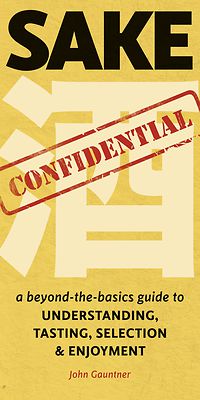 SAKE CONFIDENTAL
SAKE CONFIDENTAL
Interested in learning more about sake?
Check out my book “Sake Confidential” on Amazon.
Sake Confidential is the perfect FAQ for beginners, experts, and sommeliers.
Indexed for easy reference with suggested brands and label photos. Includes:
- Sake Secrets: junmai vs. non-junmai, namazake, aging, dry vs. sweet, ginjo, warm vs. chilled, nigori, water, yeast, rice, regionality
- How the Industry Really Works: pricing, contests, distribution, glassware, milling, food pairing
- The Brewer’s Art Revealed: koji-making, brewers’ guilds, grading

SAKE INDUSTRY NEWS
If you are interested in staying up to date with what is happening within the Sake Industry and also information on more advanced Sake topics then Sake Industry News is just for you!
Sake Industry News is a paid subscription newsletter that is sent on the first and 15th of each month. Get news from the sake industry in Japan – including trends, business news, changes and developments, and technical information on sake types and production methods that are well beyond the basics – sent right to your inbox. Subscribe here today!
Each issue will consist of four or five short stories culled from public news sources about the sake industry in Japan, as well as one or more slightly longer stories and observations by myself on trends, new developments, or changes within the sake industry in Japan.








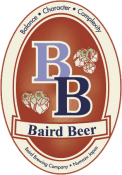


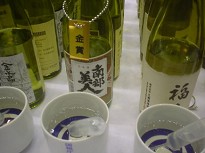
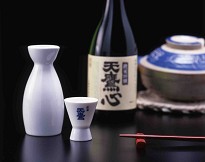
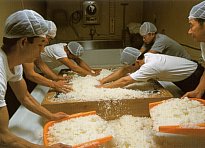
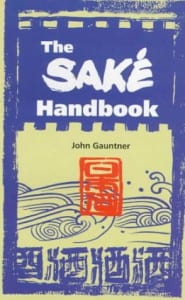
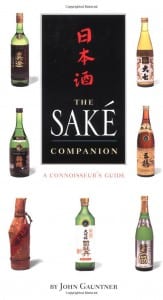

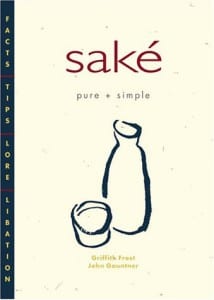

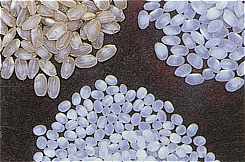



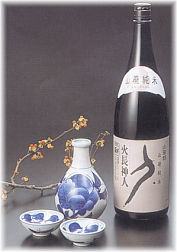 There is plenty of immensely enjoyable sake not in the top of the top classifications. In fact, sometimes such sake has more presence, uniqueness, and appeal than super dooper hoity toity high priced daiginjo. Well, sometimes, anyway. Top of PageSake is almost always fairly priced.
There is plenty of immensely enjoyable sake not in the top of the top classifications. In fact, sometimes such sake has more presence, uniqueness, and appeal than super dooper hoity toity high priced daiginjo. Well, sometimes, anyway. Top of PageSake is almost always fairly priced.